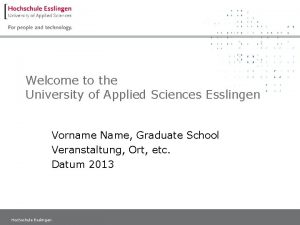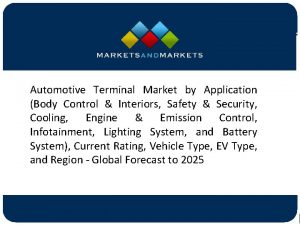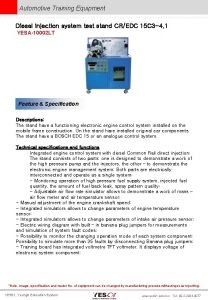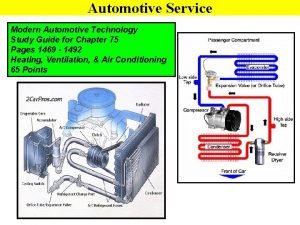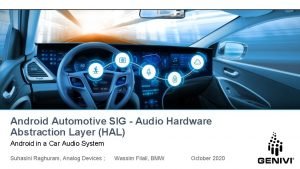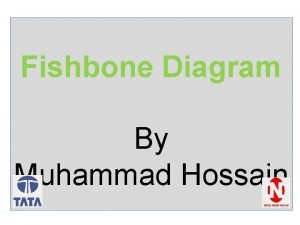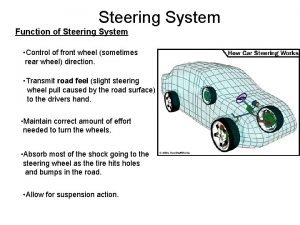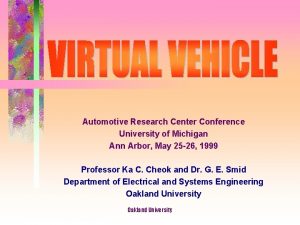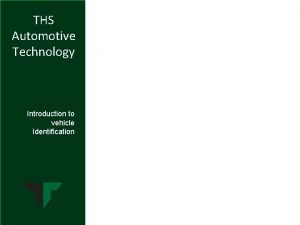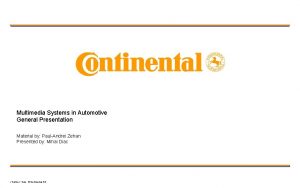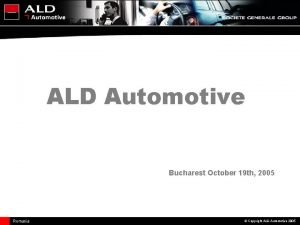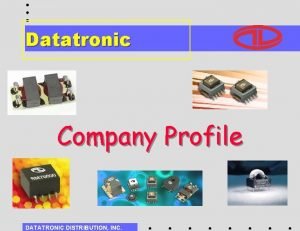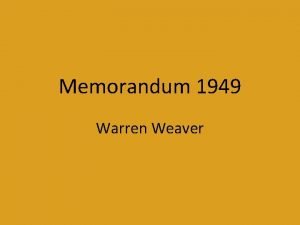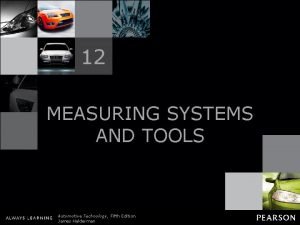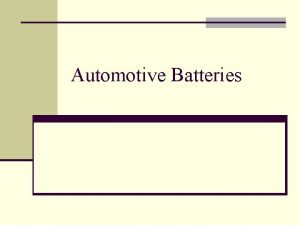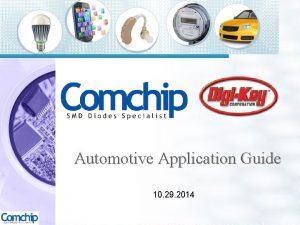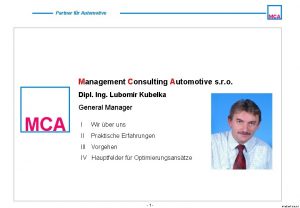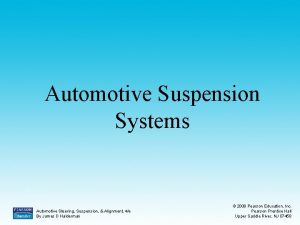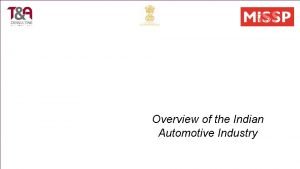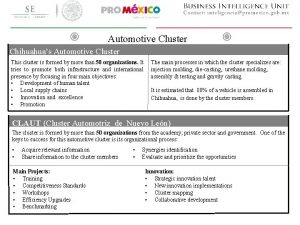Draft AIS140DF 1 May 2017 FINALIZED DRAFT AUTOMOTIVE
















































- Slides: 48

Draft AIS-140/DF 1/ May 2017 FINALIZED DRAFT AUTOMOTIVE INDUSTRY STANDARD Intelligent Transportation Systems (ITS) - Requirements for Public Transport Vehicle Operation ARAI I

Draft AIS-140/DF 1/ May 2017 CHECK LIST FOR PREPARING AUTOMOTIVE INDUSTRY STANDARD AIS-140: Intelligent Transportation Systems (ITS) - Requirements for Public Transport Vehicle Operation Sl. No. 1. 2. 3. 4. 5. 6. 7. 8. 9. 10. 11. 12. 13. 14. PARTICULARS REMARKS Indicate details of the base reference standard. (e. g. ECE / EEC Directive/GTR etc. ) NA Add an explanatory note indicating differences between the above standard and the draft, if any. Specify details of technical specifications to be submitted at the time of type approval relevant to the requirements of this standard covered. Are the details of Worst Case Criteria covered? Are the performance requirements covered? Is there a need to specify dimensional requirements? If yes, are they covered? Is there a need to specify COP requirements? If yes, are they covered? Is there a need to specify type approval, and routine test separately, as in the case of some of the Indian Standards? If yes, are they covered? If the standard is for a part/component or Sub-system; i) AIS-037 or ISI marking scheme be implemented for this part? ii)Are there any requirements to be covered for this part when fitted on the vehicle? If yes, has a separate standard been prepared? If the standard is intended for replacing or revising an already notified standard, are transitory provisions for re-certification of already certified parts/vehicles by comparing the previous test result, certain additional test, etc. required? If yes, are they included? Include details of any other international or foreign national standards which could be considered as alternate standard. Are the details of accuracy and least counts of test equipment/meters required to be specified? If yes, have they been included? What are the test equipment’s for establishing compliance? NA 15. If possible, identify such facilities available in India. Are there any points on which special comments or information 16. is to be invited from members? If yes, are they identified? 17. Does the scope of standard clearly identify vehicle categories? II Yes NA NA NA Yes NA ARAI, i. CAT NA Yes

Draft AIS-140/DF/May 2017 PARTICULARS Sl. No. REMARKS Yes 18. Has the clarity of definitions been examined? Status chart of the Standard to be used by the purchaser for updating the record Sl. No. Corrigenda Amendment Revision General remarks: 3 Date Remark Misc.

Draft AIS-140/DF/May 2017 INTRODUCTION The Government of India felt the need for a permanent agency to expedite the publication of standards and development of test facilities in parallel when the work on the preparation of the standards is going on, as the development of improved safety critical parts can be undertaken only after the publication of the standard and commissioning of test facilities. To this end, the erstwhile Ministry of Surface Transport (Mo. ST) has constituted a permanent Automotive Industry Standards Committee (AISC) vide order No. RT-11028/11/97 -MVL dated September 15, 1997. The standards prepared by AISC will be approved by the permanent CMVR Technical Standing Committee (CTSC). After approval, the Automotive Research Association of India (ARAI), Pune, being the secretariat of the AIS Committee, will publish this standard. Intelligent Transport Systems (ITS) are globally proven systems to optimize the utilization of existing transport infrastructure and improve transportation systems in terms of efficiency, quality, comfort and safety. Having realized the potential of ITS, Government bodies and other organizations in India are presently working towards implementing various components of ITS across the country. The first step taken for creation and implementation of ITS was holding a National Workshop titled “User Requirements for Interactive ITS Architecture”, which was conducted as a collaboration between SIAM and ASRTU on 26 th & 27 th February 2015. This was primarily focused on ITS in Public Bus Transportation. Nonetheless, the workshop helped to create the outline for “National Intelligent Transport System Architecture and Policy for Public Transport (Bus)”, which was submitted by ASRTU and SIAM to the government In the 44 th & 45 th CMVR-TSC, Chairman had directed - standardization activities to be initiated on Intelligent Transportation Systems (ITS) - Vehicle Location Tracking, Camera Surveillance System and Emergency Request Button. The committee intended to extend the above user requirements to all public transportation namely – buses, taxis, etc. The current document covers the requirements for Vehicle Location Tracking and Emergency Button. The other ITS components like PIS, CCTV system, Fare collection etc. are deliberated and would be addressed in later phase and could be added as separate parts to the current document. . Based on these directions, the AISC Panel on ITS has prepared this AIS-140 titled, “Intelligent Transportation Systems (ITS) - Requirements for Public Transport Vehicle Operation” The panel has also deliberated and identified the necessary elements for an effective implementation of vehicle level ITS system. This standard has been prepared by considering inputs received from all stake holders on ITS, mainly 4

Draft AIS-140/DF/May 2017 a. Directions of CMVR-TSC b. Detailed Specification Document on Vehicle Tracking Devices (dated 4 th March 2015, published by Mo. RTH) c. Report of Department of Telecom (Telecom Engineering Centre) Automotive Working Group on M 2 M enablement in Intelligent Transport System (ITS) This AIS on ITS, has been provisioned for device level approval; including construction and target vehicle level approval. Device level approval is needed to enable retro-fitment of ITS systems on in-use vehicles. This will ensure ITS Backend Control Centre infrastructure already presents with the STUs can be more fully utilized and make the investment in the Backend Control Centre infrastructure more viable. As per the direction of CMVR-TSC which needed the Communication Protocol and Backend Control Centre requirement for tracking and handling the alerts to be detailed, the same has been addressed in Section 6 & 7, as detailed below. The devices would transmit data to the Backend Control Centre using 2 G/3 G/4 G wireless connectivity (with SMS fall back) as per the protocol provided in respective sections (Section 6). The data from the devices would travel over the wireless telecom service provider network and finally get delivered at the Backend Control Centre. The detail about Device to Backend Communication Mechanism is mentioned in Section 7. BIS and AIS both have panels which are formulating standards on ITS. It is our belief that taking the AIS route for the 1 st implementation would give the faster time for adoption. Experts in the BIS panel and in DIMTS who are working on these subjects have been co-opted and invited to work in the AIS panel to make the AIS as robust as possible. Once implemented and all implementation problems in this emerging technology have been eliminated, BIS standard can be made with further inclusions if any resulting from consultations with the wider stakeholder community. Because of these reasons, we recommend the AIS route for regulation creation and first implementation. One of the major concerns which has been raised during the panel meetings is on the issue of privacy encroachments by ITS systems. Some overseas member countries of the 1958 agreement have been continuously emphasizing in WP 29 forums that the regulated ITS system must not encroach on privacy. Towards this, the panel has submitted a document titled ‘Data Privacy in Transportation ITS’ To help the system developers deal with these issues. Further, system developer can also take guidance from ‘IS/ISO/TR 12859: 2009 - Intelligent Transport Systems — System Architecture — Privacy Aspects in ITS Standards and Systems’ while developing their systems to meet the requirements of this standard. The Panel and the Automotive Industry Standards Committee (AISC) responsible for preparation of this standard are given in Annexure-D and Annexure -E respectively. 5

Draft AIS-140/DF/May 2017 CONTENTS Clause No. Details Page No. 1. 0 Scope 1/40 2. 0 Application For CMVR Type Approval 3/40 3. 0 ITS Functions and Requirements 4/40 4. 0 Communication Protocol 10/40 5. 0 Construction and Installation 16/40 6. 0 Functional, Performance, Durability, Environmental and Protocol Tests 17/40 7. 0 Device to Backend Communication Mechanism 31/40 List of Annexures ANNEXURE-A Information to be Submitted for Type Approval 34/40 ANNEXURE-B Criteria for Extension of Type Approval 35/40 ANNEXURE-C Physical Interfaces (Connectors) for Power and I/Os 36/40 ANNEXURE-D Composition of Panel 38/40 ANNEXURE-E Committee Composition 40/40 6

Draft AIS-140/DF 1/ May 2017 Intelligent Transportation Systems (ITS) - Requirements for Public Transport Vehicle Operation 1. 0 SCOPE 1. A. 0 This standard applies to both individual components as well as system environment intended to be used in Public transport vehicles. 1. A. 1 INTELLIGENT TRANSPORTATION SYSTEMS-VLT WITH AN EMERGENCY SYSTEM Requirements on ITS devices and functions - Vehicle Location Tracking and Emergency Button 1. B. 0 DEFINITIONS: For the purpose of this standard, definitions are given below: 1. B. 1 “Acquisition sensitivity” refers to the minimum signal level at which the device is able to successfully perform a cold start TTFF. The acquisition sensitivity test is a simulated signal test. 1. B. 2 “Assisted GPS (A-GPS)” is a system allowing satellite receivers to obtain information from communication network resources to assist in acquiring satellite location. A-GPS system is especially useful when the receiver is in a location where it is difficult for the satellite signals to penetrate. In addition to providing better coverage, A-GPS also improves the start-up time, which is the time required by the satellites and the receivers to establish a reliable connection. 1. B. 3 “Circular Error Probability (CEP)” is defined as the radius of a circle centered on the true value that contains 50% of the actual GPS measurements. So a receiver with 5 meter CEP accuracy will be within 5 meter of the true measurement 50% of the time. The other 50% of the time the measurement will be in error by more than one meter. 1. B. 4 “Dilution of Precision (DOP)” is the degree of proximity of the location data to their mean value. The relative position of satellites affects the accuracy of location calculation by the locating module. Location coordinates computed when the satellites are clustered together suffer from dilution of precision (DOP), a factor that multiplies the associated errors. The DOP for an ideal satellites constellation arrangement equals close to 1, which does not magnify the underlying errors. 1. B. 5 “Distance Root Mean Square (DRMS also called RMS, 1 Sigma)” This is computed as square root of the average of the squared horizontal position errors with 65% probability. The position expressed has the probability of being within a circle with radius with 65% probability. A locating module with 6 metre DRMS accuracy would be within 6 meters of its actual position 65% of the time. 1/40

Draft AIS-140/DF/May 2017 1. B. 6 “Emergency Button”A button provided in vehicle for passengers or crew members to send specialized data packet /SMS to Centralized regulatory server to indicate safety/panic situation caused by human or natural disaster or vehicle accident etc. 1. B. 7 “Global Positioning System (GPS)” is a space-based radio navigation system. It provides positioning, navigation, and timing services to military and civilian users on a continuous basis. 1. B. 8 “Sensitivity “refers to the minimum signal strength level at which locating module can successfully perform a location fix. A GNSS locating module has two different sensitivity levels – acquisition sensitivity and tracking sensitivity. 1. B. 9 “Time to First Fix (TTFF)” describes the time required for a tracking device to acquire adequate satellite signals and related data (almanac and ephemeris data) to compute location. 1. B. 10 “Tracking Sensitivity” refers to the minimum signal level at which the device is able to successfully maintain the location fix. The acquisition sensitivity test is a simulated signal test. 1. B. 11 “Vehicle Location Tracking (VLT)”device uses satellite based location technology to determine and record the precise location of a vehicle at regular intervals. The location data so determined can be stored within the device, and/or can be transmitted to the Backend Control Centre using a wireless communication modem built in the device. 1. C REFERENCES: The References are listed below. 1. C. 1 National Level Vehicle Security and Tracking System – Detailed Specification Document on Vehicle Tracking Devices (GPS) (Published by Mo. RTH). 1. C. 2 APTA TCIP - American Public Transportation Association (APTA) Standard for Transit Communications Interface Profiles (TCIP) 1. C. 3 EBSF - European Bus System of the Future 1. C. 4 ISO 11898 -1: 2003 Road vehicles — Controller area network (CAN) 1. C. 5 SAE J 1939 Recommended Practice for a Serial Control and Communications Vehicle Network. 1. C. 6 Bus-FMS-Standard 1. C. 7 SAE USCAR 18 / USCAR 18 -3 - FAKRA SMB RF CONNECTOR SUPPLEMENT 1. C. 8 National ITS Architecture - U. S. Department of Transportation 1. C. 9 ISO 17185 -1: 2014 - Intelligent transport systems — Public transport user information — Part 1: Standards framework for public information 2

Draft AIS-140/DF/May 2017 systems 1. C. 10 Trans model Standard (CEN/TC 278 WG 3/SG 4, Reference Entity. Relationship Data Model for Public Transport) - European reference data model for Public Transport operations developed within several European Projects - EN 12896: 2006 1. C. 11 Specification for Entity-Relationship for describing the main fixed objects in Public transport CEN/TC 278, 2008 - EN 28701: 2012 1. C. 12 RTIG (Real Time Information Group Ltd) - Digital Air Interface Protocol 1. C. 13 SIRI (Service Interface for Real Time Information) European Technical Specification (TS) - CEN/TS 15531 1. C. 14 Ne. TEx-Network Exchange European Technical Specification (TS) CEN/TS 16614 1. C. 15 Na. PTAN (National Public Transport Access Node) 1. C. 16 ISO 15638 -15: 2014 Intelligent transport systems – Framework for cooperative telematics applications for regulated vehicles (TARV) – Part 15: Vehicle location monitoring 1. C. 17 ISO 15638 -5: 2013 Intelligent transport systems – Framework for collaborative Telematics Applications for Regulated commercial freight Vehicles (TARV) – Part 5: Generic vehicle information 1. C. 18 NMEA-0183: The NMEA 0183 standard defines an electrical interface and data protocol for communications between marine instrumentation. 1. C. 19 IS/ISO/TR 12859: 2009 – Intelligent Transport System-System Architecture-Privacy Aspects in ITS standards and systems 1. C. 20 Report of Department of Telecom (Telecom Engineering Centre) Automotive Working Group on M 2 M enablement in Intelligent Transport System (ITS) 1. C. 21 URL: http: //tec. gov. in/pdf/M 2 M%20 Enablement%20 in%20 ITS. pdf 2. 0 APPLICATION FOR CMVR TYPE APPROVAL 2. 1 The application for CMVR device level approval shall be accompanied by information on the system specification as mentioned in Annexure A. 2. 2 Type approval shall involve following steps: 2. 2. 1 Device Approval: Approval provided at Device level for compliance to this standard. These approved devices can be fitted / retro-fitted by manufacturer/ Dealer/ permit holder/system integrator in any vehicle model provided it shall meet installation requirements as mentioned in Clause No. 5 of this standard. For manufacturers seeking vehicle level approval with approved VLT with 3

Draft AIS-140/DF/May 2017 Emergency Buttons fitted shall only require installation approval as per the provisions of Clause 5 and Sub-Clause 6. 1 of Clause 6. 2. 3 Modifications and Extension of Approval 2. 3. 1 Every modification pertaining to the information, even if the changes are not technical in nature declared in accordance with clause 2. 1, shall be intimated by the VLT with Emergency Button Manufacturer / to the test agency. 2. 3. 1. 1 If the changes are in parameters not related to the provisions, no further action need be taken. 2. 3. 1. 2 If the changes are in parameters related to the provisions, the test agency, which has issued the certificate of compliance, may then consider, based on the justification provided by the VLT with Emergency Button Manufacturer and reviewed by the test agency, whether, The model with the changed specifications still complies with provisions; Or, Any further verification is required to establish compliance. 2. 3. 2 In case of 2. 3. 1. 2, tests for only those parameters which are affected by the modifications need be carried out based on Criteria for extension of type approval as per Annexure B. 2. 3. 3 In case of fulfilment of criterion of clause 2. 3. 1. 1 or after results of further verification as per clause 2. 3. 1. 2 are satisfactory, the approval of compliance shall be extended for the changes carried out. 3. 0 ITS FUNCTIONS AND REQUIREMENTS The list of ITS functions envisaged from this device type is set out below in Table 3 A – Table 3 A: List of ITS Functions and Sub Functions Function Safety and Security Sub Functions Emergency Buttons Vehicle Location Tracking (VLT) The above functions and their requirements shall be met by only single device that can be interfaced by external emergency buttons. The communications to Backend Control Server (Government authorized server) shall be done by device as per the protocol and functionalities defined below. 3. 1 Vehicle Location Tracking (VLT) With Emergency Button 3. 1. 1 Functional Requirements for VLT 4

Draft AIS-140/DF/May 2017 3. 1. 1. 1 Device shall be capable of obtaining position information using Global Navigation Satellite System (GNSS). GNSS receiver specifications are as follows: a. Device shall be capable for operating in L and/or S band include support for NAVIC/IRNSS (Indian Regional Navigation Satellite System) for devices installed on or after 1 st April, 2018. b. The Device shall support GAGAN, the Indian SBAS (Satellite Based Augmentation System) c. Device shall have a position accuracy of minimum 2. 5 m CEP or 6 m 2 DRMS d. Device shall have an acquisition sensitivity of minimum (-) 148 d. Bm e. Device shall have an tracking sensitivity of minimum (-) 165 d. Bm f. Device shall have an internal antenna; however if in case of Integrated systems with vehicle / aftermarket OEM approved kits if the fitment location prevents the internal antenna from functioning, then external antenna shall be provided. 3. 1. 1. 2 Device shall support standard minimum I/Os as mentioned: 4 Digital, 2 Analogue and 1 Serial Communication (e. g. RS 232) for interfacing external systems (E. g. Digital input for Emergency request button interfacing). 3. 1. 1. 3 Device shall be capable of transmitting data to Backend Control Server (Government authorized server) via Wide Area (Mobile) Communications network (GSM/GPRS) as per Communication Protocol in Section 4. 3. 1. 1. 4 Device shall be capable of transmitting Position, Velocity and Time (PVT data) along with heading (direction of travel) to a Backend Control Server (Government authorized server) at configurable frequency as per Communication Protocol of Section 4. The fixed frequency shall be user configurable, minimum frequency shall be 5 sec during vehicle operation and not less than 10 minutes in sleep/IGN OFF) as per the protocol defined in Communication Protocol of Section 4. 3. 1. 1. 5 Device shall be capable of transmitting data to minimum 2 different IP addresses (1 IP address for regulatory purpose (PVT data) and 1 IP address for Emergency response system other than the IP’s required for Operational purpose. 3. 1. 1. 6 On pressing of Emergency button, the system implementing VLT function shall send emergency Alert (Alert ID 10 as mentioned in Subsection 4. 2. 1 of Communication Protocol Section 4) to the configured IP address(s) as per the Communication Protocol mentioned in Section 4. In the absence of GPRS network, the emergency alert shall be sent as SMS message along with vehicle location data to configured control center number(s). The SMS shall consist parameters as given in Sub-section 4. 2. 2. 5

Draft AIS-140/DF/May 2017 3. 1. 1. 7 Device shall have an internal back-up battery to support 4 hours of normal operations (to be tested for positional record transmission at a frequency of 60 sec) 3. 1. 1. 8 Device shall be capable of transmitting alerts to the Backend Control Server (Government authorized server) directly. The applicable list of alerts is given in Section 4. 2 (Alert ID 3 to 12) of Section 4. 3. 1. 1. 9 Device shall support over the air software and configuration update. 3. 1. 1. 10 Device shall support basic standard configuration (Mobile communications network settings, Backend Control Server (Government authorized server) details, data frequencies, alert thresholds etc. ) as per configuration specification defined in Section 4. 3. 1. 1. 11 Device shall support store and forward mechanism for all type of data (periodic data and alerts) meant for backend transmission. The system shall store data in internal memory during communication network unavailability and transmit the data when the connection resumes in last in first out (LIFO) manner. The live data shall be given higher priority for transmission than back log (stored data) at any point in time. 3. 1. 1. 12 The Device shall have a unique identifier for identifying the VLT device and data. The unique ID shall be stored in a read only memory area so that it cannot be altered or overwritten by any person. The unique identifier may be Vehicle Identification number or IMEI (International Mobile Station Equipment Identity) Number. 3. 1. 1. 13 Device shall store/write the registration number of the vehicle in the internal nonvolatile memory. 3. 1. 1. 14 Device shall have an Embedded SIM. 3. 1. 1. 15 Device shall be designed to operate between 8 VDC and 32 VDC using vehicle battery input voltage range 12 /24 Volts. 3. 1. 1. 16 Device shall have a sleep mode current ≤ 20 m. A (If the function is implemented in a dedicated system/device). 3. 1. 1. 17 Device shall support any operational GNSS system with 12 (minimum) acquisition channels. 3. 1. 1. 18 The Device shall support: • Location on GPRS/SMS • Non-volatile memory to store min 40, 000 positional log • Configurable backup SMS facility in case of GPRS failure • Capability to send serving and adjacent cell ID as well as network measurement report (NMR) 6

Draft AIS-140/DF/May 2017 3. 1. 1. 19 The Device GNSS module shall have: • The capability of Hot start <5 s • The capability of Warm start : < 30 s • The capability of Cold start < 40 s 3. 1. 1. 20 Device shall support Outputs as per NMEA 0183 3. 1. 1. 21 The Device GPRS module shall have: • Multi slot GPRS with In - built Quad-band GPRS module/Modem • GPRS class 10 or above • Support Embedded SIM to cater to the automotive operational requirement such as vibration, temperature and humidity and provide long life span with at least 10 years life and more than 1 million read/write cycles • GPRS module & SIM shall support o SMS, Data (GPRS, TCP/IP) and o Support multiple network OTA switching (on-demand/automatic) capabilities. 3. 1. 1. 22 Device shall be dust, temperature, vibration, water splash resistant, IP 65 rated or better, tamper proof as per Section 6. 3. 1. 1. 23 Device shall be manufactured using processes as per quality management standard for automotive industries i. e. ISO/TS 16949 updated from time to time 3. 1. 1. 24 Device shall support A-GPS (Assisted GPS) 3. 1. 1. 25 Device shall have provision of secured data transmission to the Backend Control Centre from the devices through secured channel (e. g. secured dedicated APN). 3. 1. 1. 26 Device shall have 3 axis accelerometer and 3 axis gyroscope for getting the alerts on harsh breaking harsh acceleration, and rash turning. 3. 1. 2 Functional Requirement for Emergency System 3. 1. 2. 1 Passengers or in-vehicle crew present in the vehicle shall be able to make an emergency request by pressing the emergency button provided 3. 1. 2. 2 The emergency request function shall not exist as standalone. The function shall be part of Vehicle Location Tracking (VLT) system. An alert shall be sent to the Backend Control Server (Government authorized server) when emergency request is raised. De-activation shall always be from authorized government server who receives alert message i. e. NERS system as mentioned in Sub-section 4. 2. 2. 7

Draft AIS-140/DF/May 2017 3. 1. 2. 3 The Emergency Buttons will be 'Normally Closed' (NC) type. The form factor of Emergency Buttons will be such that the button is easy to press in the case of an emergency, and simultaneously also minimizes the possibility of accidental or unintended press thereby causing a false alert. 3. 1. 2. 4 On pressing of Emergency button, the system implementing VLT function shall send emergency Alert (Alert ID 10 as mentioned in Subsection 4. 2. 1 of Communication Protocol Section 4) to the Backend Control Server (Government authorized server) as per the Communication Protocol mentioned in Section 4. In the absence of GPRS network, the alert shall be sent as SMS message along with vehicle location data to configured control center number. The SMS shall consist of parameters as given in Sub-section 4. 2. 2. 3. 1. 2. 5 In absence of both GPRS and GSM networks and on pressing of Emergency Button, the system implementing VLT function shall store the emergency Alert (Alert ID 10 as mentioned in Sub-section 4. 2. 1 of Communication Protocol Section 4). Once the GPRS or GSM is available, this alert information shall be sent on high priority to the configured IP addresses as per the communication protocol mentioned in Section 4 or as SMS message along with vehicle location data to configured control center number. The SMS shall consist of parameters as given in Sub-section 4. 2. 2. 3. 1. 3 Configuration of Device Parameters Over the Air (OTA) The device shall support at least the below parameters to be configurable over the air (through SMS and GPRS). The updation shall be allowed only over an ‘authenticated’ channel: 1. Setting/ Change of the Primary or Secondary IP and port number 2. Setting/ Change of the APN 3. Set configuration parameter like sleep time, overspeed limit, harsh braking, harsh acceleration, rash turning threshold limits etc. 4. Emergency control SMS Centre Number(s) 5. Configuring the vehicle registration number 6. Configuring the frequency of data transmission in normal / Ignition state / OFF state sleep mode/ Emergency state, etc. 7. Configuring the time duration for Emergency state 8. Capability to reset the device 9. Command to get the IMEI of the device Configurable commands must involve the following features: SET: For setting the parameters. GET: For enquiring regarding the parameters such as mobile number, GSM strength, vehicle number and other important parameters. CLR: For clearing certain commands, alarms, alerts etc. After each SET, GET, CLR command the device should send alert to 8

Draft AIS-140/DF/May 2017 Backend Control Centre, as mentioned in Section 4 Alert 12, giving the details of Mode, mobile no/ IP of control center sending commands. 3. 1. 4 Tracking Device Health Monitoring Parameters The device shall send status of health parameters at configurable interval and this threshold value shall also be configurable over the air. It shall be possible for health parameters to be fetched on demand via command as set out below in Table 3 B: Health Monitoring Parameter Sl. No. 3. 1. 5 Field Description 1 Start Character $ 2 Header The header of the packet/ identifier 3 Vendor ID Vendor identification header 4 Firmware Version details of the Firmware used in EX. 1. 0. 0 5 IMEI Identified of the sending unit. 15 digit standard unique IMEI no. 6 Battery percentage Indicates the internal battery charge percentage 7 Low battery threshold value Indicates value on which low battery alert generated in percentage 8 Memory percentage Indicates flash memory percentage used 9 Data update rate when ignition ON Indicates Packet ignition ON frequency on 10 Data update rate when ignition OFF Indicates Packet ignition OFF frequency on 11 Digital I/o status Inputs connected to the device. 12 Analog I/o status Analog input status 13 End character * SMS Fall Back In case of emergency state, (i. e. on pressing of Alert button), the device will shift to the SMS mode in case GPRS connectivity is not available. In such case, the device will send the Alert message and tracking data through SMS mode. Since SMS has the limitation of sending only 160 characters, so the tracking data to be sent in one SMS will have fields IMEI, Latitude, Direction, Longitude, Direction, location fix, speed, Cell ID, LAC (Location Area Code), Date and Time as per emergency alert. The details is provided in Sub-section 4. 2. 2. 9

Draft AIS-140/DF/May 2017 4. 0 COMMUNICATION PROTOCOL 4. 1 Data Frame Format Table below (Table 4 A) contains the listing of fields that the vehicle tracking devices would be required to send to the Backend Control Centre. The first 3 fields (Start character, Header for VLT with Emergency Buttons and Vendor ID, who has supplied the device) must be fixed in position as well as format (Header part of frame). Rest all other fields are required to be present in the location data sent by the devices to the backend, but can be in any sequence or with any separator between fields. The data value can be either in American Standard Code for Information Interchange (ASCII) or in HEX format. Device must transmit the Login message whenever it establishes (re-establishes after disconnection) its connectivity with Server with the specified fields. Login Message will carry following information: • $Device. Name –Vehicle number on which the device is installed • $IMEI – 15 Digit IMEI number • $Firmware – Version of the firmware used in the hardware • $Protocol -Version of the frame format protocol. • $Last. Valid. Location – Last location info saved at the device. Table 4 A: Data Message Format Field Description Start Character $ Header The header of the packet/ identifier Vendor ID Vendor identification header Firmware Version details of the Firmware used in EX. 1. 0. 0 Packet Type Specify the packet type Sample Data $ 1. 0. 0 Depending upon the context, every frame NR = Normal from tracking device EA = Emergency Alert must carry a TA = Tamper Alert qualification code. This helps to determine the (Optional) state in which vehicle is HP = Health Packet at that time. IN = Ignition On IF = Ignition Off BD = Vehicle Battery Disconnect BR = Vehicle Battery 10

Draft AIS-140/DF/May 2017 Reconnect Packet Status BL = Internal Battery Low L=Live or H= History L IMEI Identified of the sending unit. 15 digit standard unique IMEI no. Vehicle Reg. No Mapped vehicle DL 1 PC 9821 registration number GPS Fix 1 = GPS fix OR 0 = GPS 1 invalid Date value as per GPS date time (DDMMYYYY) Time value as per GPS 050656 date time in UTC format (hhmmss) Latitude value in decimal degrees (not less than 6 places) 28. 758963 Latitude Dir Latitude Example N Direction. 123456789012345 220714 N=North, S= South Longitude value in decimal degrees (not less than 6 places). 77. 6277844 Longitude Direction. W E=East, W= West Speed of Vehicle as Calculated by GPS module in VLT. (in km/hrs. ) (Upto One Decimal Value) Course over ground in degrees 25. 1 No of Satellites Number of satellites available for fix 8 Altitude of the device in meters 183. 5 PDOP Positional dilution of precision HDOP Horizontal dilution of precision Heading 11 310. 56

Draft AIS-140/DF/May 2017 Network Operator Name of Network Operator INA Airtel Ignition 1= Ignition On , 0 = Ignition Off 1 Main Power Status 0 = Vehicle Battery disconnected 1= Vehicle reconnected Main Input Voltage Internal Voltage Battery Indicator showing 12. 5 source voltage in Volts. (Upto One Decimal Value) 4. 2 Battery Indicator for level of battery charge remaining. (Upto One Decimal Value) Emergency Status 1= On , 0 = Off 0 Alert C = Cover Closed, O = Cover Open C Signal Value Ranging from 0 – 31 25 Tamper (Optional) GSM Strength 1 MCC Mobile Country Code 404 MNC Mobile Network Code 10 LAC Location Area Code 00 D 6 Cell ID GSM Cell ID CFBD NMR (Network Neighbouring 4 cell ID Measurement along with their LAC & Report) signal strength Neighbouring Cell ID Digital Input Status 4 external digital input status (Status of Input 1 to Input 3 (0=Off; 1=On)) 0001 Digital Output Status 2 external digital output status 01 (0=Off; 1=On) Frame Number Sequence Number of the 000005 messages (000001 to 999999) Checksum Insures No error in 16 transmission (optimal) 12

Draft AIS-140/DF/May 2017 End Character Indicated End of the * frame 4. 2 Messages & Alerts from Devices 4. 2. 1 Table below (Table 4 B) contains the listing of alerts that need to come from the tracking devices. These alerts are applicable for both live packets as well as the history packets. Table 4 B: Messages & Alerts Supported Alert ID Message & Alerts Remarks 1. Location Update Default message coming from each device 2. Location Update (history) Would be sent, if GPRS is not available at the time of sending the message in protocol format Zero, BLANK, NIL, etc. 3. Alert – Disconnect from If device is disconnected from main battery vehicle battery and running on its internal battery 4. Alert – Low battery 5. Alert – Low battery removed Indicates that device internal battery is charged again 6. Alert – Connect back to main battery Indicates that device is connected back to main battery 7. Alert – Ignition ON Indicates that Vehicle’s Ignition is switched ON 8. Alert – Ignition OFF Indicates that Vehicle’s Ignition is switched OFF 9. Alert – GPS box opened (Optional) Optional message would be generated indicating GPS box opened 10. Alert – Emergency state When any of the emergency ON* button is pressed 11. Alert – emergency State When emergency state of vehicle OFF is removed 12. Alert Over the air parameter change If device internal battery has fallen below a defined threshold 13 When any parameter is changed over the air. Shall include the name of parameter changed and source of command

Draft AIS-140/DF/May 2017 4. 2. 2 13. Harsh Braking Alert indicating braking. for harsh 14. Harsh Acceleration Alert indicating acceleration. for harsh 15. Rash Turning Alert indicating for Rash turning. 16 Device Tempered Alert Indicating Emergency button wire disconnect/ wire cut etc. In case of emergency alert, the alert message shall be sent to 2 different IP addresses hence the device shall support minimum 2 IP addresses (1 IP address for regulatory purpose (PVT data) and 1 IP address for Emergency response system other than the IP’s required for Operational purpose. The PVT data will send the emergency alert to the system. Primary alert will go to the emergency response Backend Control Centre (NERS/ MHA) as may be notified by the Government of India in the schema below: Primary alert will go to the emergency response Backend Control Centre as notified by the Government of India in the indicative format below (Table 4 C): Table 4 C: Indicative Format for Alert to Emergency Response System Attribute Value / Description Size Packet Header EPB, The unique identifier for all messages from VLT Character, 3 bytes Message Types supported. Character, 2 bytes Emergency Message (EMR) or Stop Message (SEM) 14

Draft AIS-140/DF/May 2017 Vehicle ID Unique ID of the Vehicle Character, 15 bytes (IMEI Number) Packet Type NM – Normal Packet, Character, 2 bytes Date and time of location the location obtained from the data in DDMMYYYY hhmmss format Character, 14 bytes GPS Validity A – Valid, Character, 1 byte Latitude in decimal degrees dd. mmmmmm format Double, 12 bytes Latitude Direction N – North, Character, 1 byte Longitude in decimal degrees dd. mmmmmm format Double, 12 bytes Longitude Direction E – East Character, 1 byte Altitude in meters (above sea level) Double, 12 bytes Speed of Vehicle as Calculated by GPS module in VLT. (in km/hr) Float, 6 bytes Distance calculated from previous GPS data Float, 6 bytes Provider G - Fine GPS Character, 1 byte SP – Stored Packet V – Invalid S – South W – West N - Coarse GPS or data from the network Number of the Character, 16 bytes Vehicle Regn. No Registration Vehicle Reply Number The mobile number to which Test 0 response needs to be sent. (Emergency Mobile No. as specified by MHA/Mo. RTH/States. ) CRC The 32 bit checksum of all the characters from the header up to the CRC field 8 bytes *Above format is indicative only. These Format will be notified by the Government of India time to time. 15

Draft AIS-140/DF/May 2017 4. 3 Testing of Configuration of Device Parameters Over the Air (OTA) The following testing will be done for 1. Setting/ Change of the Primary or Secondary IP and port number 2. Setting/ Change of the APN 3. Set configuration, parameter like sleep time for speed, harsh braking, rash turns, etc. 4. Emergency SMS Centre Number 5. Configuring the vehicle registration number 6. Configuring the frequency of data transmission in normal / Ignition state / OFF state sleep mode, Emergency state, etc. 7. Configuring the time duration for Emergency state 8. Capability to reset the device 9. Command to get the IMEI of the device Configurable commands must involve the following features: SET: For setting the parameters. GET: For enquiring regarding the parameters such as mobile number, GSM strength, vehicle number and other important parameters. CLR: For clearing certain commands, alarms, alerts etc. 5. 0 CONSTRUCTION AND INSTALLATION (To be verified on component level and target vehicle level approval) 5. 1 Requirements on vehicle interface for VLT with Emergency Button Connector for Power The requirements for interface shall be as below or as agreed between vehicle manufacturer and device manufacturer. Standard connectors conforming to ISO 15170 shall be used at vehicle side. Connector requirements shall be as per Annexure – C, Clause 1. 1 (Sl. No 1 - Low power systems 1) However, Device/System side connector/s shall be pre-agreed with equipment manufacturer by Vehicle OEM in the case of OE fitment of the systems System supplier in case of retro fitment in aftermarket. These requirements do not apply to integrated systems with vehicle where integration is done by vehicle manufacturer and /or System Integrator. 16

Draft AIS-140/DF/May 2017 5. 2 Requirement of Emergency System Emergency button shall be one time press type. Separate release action from authorized server shall be required to bring back the emergency button to normal mode or clear emergency flag. 5. 3 Physical Mounting The VLT system shall be mounted in a suitable location such a way that it is not easily accessible /exposed to passengers. This requirement shall not be applicable in case of combined systems VLT with HMI (Human Machine Interface) display in front of driver. Test agency to verify this on vehicle level approval. Emergency button(s) shall be fitted in such a way that every passenger including driver shall be able to access the Emergency button(s). Passenger Car shall have 2 emergency buttons on each passenger row easily assessable by each of the passenger. There shall also be one dedicated emergency button for the driver. Passenger Transport bus shall have emergency buttons at locations easily visible & assessable to all the passengers such as every 2 meters on both the sides on passenger seating area. For seats reserved for ladies there shall be a dedicated panic button for each row. Test agency to verify this on vehicle level approval. 17

Draft AIS-140/DF/May 2017 5. 4 Power Supply The vehicle tracking device will be installed on vehicles in which the power supply voltage from vehicle battery is widely varying (12 V, 24 V etc. ) and also the power supply is not as stable as that in case of fixed locations, especially during engine start-up and braking when the voltage can fall to as low as 9 V. Typically electronic devices are very sensitive to power surges and spikes, and equipment may fail if they do not receive stable power supply. The devices will need to have a resilient power supply unit that can withstand such fluctuations and the devices also need to have power backup so that they continue to function for some duration when the vehicle battery is not functional or is disconnected from the devices. 5. 4. 1 Vehicle power interface shall have One common ground linked to vehicle chassis One permanent power Supply (12/24 V) connected to the vehicle battery One non-permanent power line (12/24 V) connect to the battery after ignition Electrical Wiring The wiring harness used in the device shall be tested for flammability as per IS 2465. 6. 0 FUNCTIONAL, PERFORMANCE, ENVIRONMENTAL AND PROTOCOL TESTS 6. 1 Vehicle Level Functional Tests DURABILITY, Following functionalities for each of the systems shall be demonstrated at the vehicle, in case system is provided by the vehicle OEM. 6. 1. 1 Vehicle Location Tracking With Emergency Button 6. 1. 1. 1 Vehicle OEM shall only provide/ installed devices approved under component level testing. 6. 1. 1. 2 System transmits PVT information to Backend Control Center (2 different IPs) at user configurable frequency (minimum 5 seconds) via GSM/GPRS. 6. 1. 1. 3 System to communicate to control center on the occurrence of the alerts captured in Communication Protocol of Section 4. 6. 1. 2 Emergency Request Emergency request function- When the emergency buttons (as applicable) placed anywhere in the vehicle is pressed by any passenger / crew, make sure that the emergency request message is send/received at the control center. 6. 2 Component Level Functional Tests Following functionalities for each of the systems shall be demonstrated. At the choice of the manufacturer, these functionalities can also be alternately demonstrated at the vehicle level and shall be deemed to be complied with at component level as well. 18

Draft AIS-140/DF/May 2017 6. 2. 1 Vehicle Location Tracking 6. 2. 1. 1 Standard connector provided for Power and other signals as per Annexure C 6. 2. 1. 2 Configuration of device as per the standard format mentioned in Section 4. Local configuration upload shall be verified Configuration upload from control center shall be verified 6. 2. 1. 3 Vehicle Location data transmission to Backend Control Center. 6. 2. 1. 4 Backend Control Centre shall be able to check the version of firmware loaded on the system. 6. 2. 1. 5 Update the firmware of the system from Backend Control Centre 6. 3 Device Level Functional, Performance & Durability Tests The tests to be performed for device level approvals are as listed below. These functionality check will be performed after each test as acceptance criteria – Tested systems shall satisfy general functional requirements at all the specified ranges during the test and after the test. Following to be checked after testing: i) Tracking functionality shall be checked via Backend Control Centre for the VLT system (Functional Test number 1 as per “Table 6 A Functional Testing”. 6. 3. 1 Functional Testing as described in the Table 6 A below shall be done with the acceptance criteria in Table 6 A after completion of all the Performance & Durability Tests as listed in Table 6 B. Table 6 A: Functional Testing Sl. No 1 Test Tracking Functionality Test Procedure The test shall be conducted on VTL to determine the proper functioning of VLT with Emergency Button by testing its connectivity to Backend Control Centre (Government authorized server). Procedure: The VLT with Emergency Button shall be connected to vehicle battery to switch it on. The VLT with Emergency Button shall be tested for the connectivity to server and its capability to send two location messages 19

Draft AIS-140/DF/May 2017 2 Location Accuracy Test This test shall be conducted on VLT with Emergency Button. The receiver is placed into a cold start state – usually by a command sent to the receiver through a test connection – and then a fairly strong navigation signal simulating in L and/or S band is sent. The time it takes for the receiver to determine its first good location fix is recorded. Test is done many times (>15 times) over many conditions and the results are averaged. Acceptance Criteria: 2. 5 m CEP or 6 m 2 DRMS 3 Acquisition Sensitivity Test This test shall be conducted on VLT with Emergency Button. Procedure: Set the simulator to output navigation signal simulating L and/or S band to a particular location with a very level so that the tracking is not possible. Gradually increase the signal level that allows the receiver to successfully perform a cold start TTFF within a specified time frame. The minimum signal level that allows acquisition is referred as to the acquisition sensitivity. Acceptance Criteria: The acquisition sensitivity shall be minimum (-) 148 d. Bm. 4 Tracking Sensitivity Test This test shall be conducted on VLT. Procedure: The device under this test is locked on to the simulator's output frequency (navigation signal simulating L and/or S band) and the simulator power output is lowered until the lock is lost. Multiple repetition of the test with different satellite geometries ensures that an accurate average measure is recorded. Acceptance Criteria: The tracking sensitivity shall be equal to or better than (-) 165 d. Bm. 20

Draft AIS-140/DF/May 2017 5 Cold-Start Time to First Fix (TTFF) Test The device in this test is placed into a cold start state. The time it takes for the device to determine its first good location fix is recorded. The cold start test is performed several times and the results are averaged. Acceptance Criteria: The cold start TTFF shall be less than 40 seconds at Open Sky condition or (-) 130 d. Bm. 6 Warm-Start Time to First Fix Test In this test the device is started in warm start mode and time taken by device to determine the first valid location fix is recorded. This is done several times and results are averaged. Acceptance Criteria: The warm start TTFF shall be less than 30 seconds at Open Sky condition or (-) 130 d. Bm. 7 Hot-Start Time to First Fix Test In this test the device is started in Hot start mode and time taken by device to determine the first valid location fix is recorded. This test is performed several times and results are averaged. Acceptance Criteria: The hot start TTFF shall be less than 5 seconds. 8 SIM Test This test is to check the suitability of the SIM and communication module. The test shall be conducted to determine the effectiveness and operation of the GPRS module with OTA network switching capabilities on demand as well as automatically in real-time. The test consist of two type of testing as below: 1. The device would be tested to perform as per the protocol using an embedded SIM. 2. The GPRS module & SIM, shall support: o SMS, Data (GPRS, TCP/IP) and o Support multiple network OTA switching capabilities (On Demand as well as Automatic Switching on realtime basis) Acceptance Criteria: In the testing, vendors has to demonstrate the embedded SIM based tracking and multiple network OTA switching capabilities (On Demand as well as Automatic Switching on real-time basis) for effective network management and transmission. 21

Draft AIS-140/DF/May 2017 9 Interference Test Interference testing is a type of test, in which Cold Start/Hot Start test are performed with device exposed to interfering signals and the performance as recorded. In this test, the GPS receiver is turned on and allowed to achieve a location fix. The jamming signal is then added to the GPS signal at a level that is detectable to the GPS receiver. The jamming signal power level is increased in 1 d. B increments until the first degradation of the GPS receiver is noticed. This is typically a dropped satellite. The jamming signal power level is again slowly increased until the GPS receiver loses its 3 D navigation fix. Acceptance Criteria: The Interference shall not result in any degradation of the Cold Start/Hot Start TTFF times. In addition, it shall not result in any degradation of the absolute location accuracy required and the same shall be 2. 5 m CEP or 6 m 2 DRMS. 10 Multipath Test This test is a simulated frequency test conducted to determine the effect of multipath signals. The signal from a single satellite is simulated to arrive at the device via two or more paths. One path is typically a direct path, and other paths are typically a reflection of the same signal from building or structure. Multipath testing is a kind of a meta-test in that some of the above tests are done with the addition of multi-path simulation of one or more satellites by the GPS signal simulator. Acceptance Criteria: The multipath shall not result in any degradation of the Cold Start/Hot Start TTFF times. In addition, it should not result in any degradation of the absolute location accuracy required and the same shall be 2. 5 m CEP or 6 m 2 DRMS. 6. 3. 2 Performance & Durability Test The Performance & Durability Test is listed in Table 6 B: Performance & Durability Test Sl. No 1 Test Procedure Test Shock test is performed to provide a degree of confidence that the device can physically and functionally withstand the relatively 22

Draft AIS-140/DF/May 2017 infrequent, non-repetitive shocks encountered in transportation environments. This test provides an assessment of the effect of the shocks on the performance of the device. The test shall be performed as per IS 9000 -part 7 – 2006. Severity Level = 15 g, Impact duration = 11 ms, Impact Type = Half sine, Total number of impact = 9 (3 on each axis) Acceptance Criteria: Device after the shock test shall be required to meet the provisions of Functional Test Number 1 as listed in Table 6 A. 2 Vibration Test This test is performed to check that the device can physically and functionally withstand the vibration exposures in the life cycle typically encountered in a vehicular environment. The test shall be performed as per IS 9000 -part 8 – 1981. The test specimen mounted on a suitable support shall be rigidly fixed on a suitable vibrating machine constructed to produce simple harmonic function (total amplitude of 1. 5 mm) and shall be subjected to vibration through a frequency range of 1055 -10 Hz in a sweep period of 1 min with continuously varying frequencies. The vibration shall be applied for not less than 1 h in the directions of each of the 3 major axes of the light. Acceptance Criteria: During and after the test the device shall be required to meet the provisions of Functional Test Number 1 as listed in Table 6 A. 3 Ingress Protection (IP) The vehicle tracking devices must be able to work in dusty environment that are typically encountered by the public transport vehicles where these would be installed. IP rating (IS/ IEC 60529 - 2001) is used for specifying the environmental protection characteristics of the tracking device. The device will be tested for dust and water ingress according to IP 65 rating. Acceptance Criteria: The device shall be required to meet the provisions of Functional Test Number 1 as listed in Table 6 A. 23

Draft AIS-140/DF/May 2017 4 EMI /EMC The Electromagnetic Interference (EMI) and Electromagnetic Compatibility (EMC) tests are performed to assess whether the device performs its intended functions in the electromagnetic environment to which it would be exposed. Further, the device shall not generate electromagnetic disturbances that may influence other equipment in the vicinity. Acceptance Criteria: The device shall meet the EMI/EMC requirements as per AIS 004 (Part 3). 5 Battery Backup Test Battery backup is the amount of time that the device battery can support sending the data without being connected to the power source. This test will be performed by disconnecting the input charging voltage to the device. On disconnecting the external supply, battery would use its charge capacity to send data through GPRS. Time duration between external power disconnect to the last data packet time denotes the battery backup time. Acceptance Criteria: Device shall be able to work in active mode for a period of 4 hours or more at the polling/ transmission rate of 60 sec 6 Reverse Polarity Protection without Fuse The device to be tested shall be connected to a reversed voltage of 14 V for 12 V systems and 27 V for 24 V systems for 2 min after connecting the system to the suitable circuit. Acceptance Criteria: After test; the device shall be required to meet the provisions of Functional Test Number 1 as listed in Table 6 A 7 Wiring Harness Flammability Test: The wiring harness used in the device shall be tested for flammability as per IS 2465. 8 Wiring Harness Electrical Properties As per AIS 028 Free Fall IS 9000 (Part VII/Sec 4) Free fall at 500 mm. 9 or DIN 72551 or ISO 6722 Acceptance Criteria: After test the device shall be required to meet the provisions of Functional Test Number 1 as listed in Table A 24

Draft AIS-140/DF/May 2017 10 Performance Parametric Test (Nine points, tri temperature/tri voltage) During testing, VLT with Emergency button shall be kept inside test chamber in power ON condition. (System shall be stabilized for minimum 5 min at each condition. At each test point the system will be powered on and shut down 5 times with a duration of 1 min ON and 1 min OFF time) Following are the various voltages & temperatures 24 V System 12 V System 18 V, -25°C 9 V, -25°C 18 V, +80°C 9 V, +80°C 18 V, Room Temperature 9 V, Room Temperature 27 V, -25°C 13. 5 V, -25°C 27 V, +80°C 13. 5 V, +80°C 27 V, Room Temperature 13. 5 V, Room Temperature 32 V, -25°C 16 V, -25°C 32 V, +80°C 16 V, +80°C 32 V, Room Temperature 16 V, Room Temperature Acceptance Criteria: The device shall be required to meet the provisions of Functional Test Number 1 as listed in Table A for each value of the temperature and voltage 11 Insulation Resistance Test shall be conducted as per ISO 167502: 2010 after damp heat test mentioned in point 3 of the Section 6. 4. System/components shall remain 0. 5 h at RT after the damp heat test. Test shall be conducted With a voltage of 500 V DC. Acceptance Criteria: Insulation Resistance shall be > 1 MΩ. No arcing or puncturing of insulation allowed shall be observed 25

Draft AIS-140/DF/May 2017 12 Load Dump Test Pulse 5 a VLT shall be tested for this. For 12 V System: A Voltage spike of 65 V, 4 Ohms 200 ms pulse-5 a as per standard ISO 7637 -2: 2004 For 24 V System: A Voltage spike of 123 V, 8 Ohms 200 ms pulse-5 a as per standard ISO 7637 -2: 2004. Acceptance Criteria: Device shall meet functional class A as per ISO 7637 -2: 2004. After test, the device shall be required to meet the provisions of Functional Test Number 1 as listed in Table 6 A. 6. 3. 3 Device Level Environmental Tests The environmental tests to be performed for device level approvals are as listed in Table 6 C. Following to be checked after testing: i) Tracking functionality shall be checked via Backend Control Centre for the VLT with Emergency Button. Table 6 C: Device Level Environmental Test Sl. No 1 Test Procedure Dry Heat / High Temperature Test The high temperature test is used to evaluate effects of high temperature conditions on safety, integrity, and performance of the device. The test shall be carried out in accordance with Indian Standard IS: 9000 (Part 3/Sec 5) the device shall be subjected to temperature of 70 ± 2°C for 16 h in high temperature. Test with device in working condition. The recovery period shall be 2 h. Acceptance Criteria: Device during and after the high temperature test the device shall be required to meet the provisions of Functional Test Number 1 as listed in Table 6 A. 2 Cold Test The test shall be carried out in accordance with IS 9000 (Part 2/Sec 4 - 1977). The device under test shall be subjected to temperature of – 10 ± 2°C for 2 h with device in working condition. The recovery period shall be 2 h. Acceptance Criteria: Device during and 26

Draft AIS-140/DF/May 2017 after the cold test, the device shall be required to meet the provisions of Functional Test Number 1 as listed in Table 6 A. 3 Damp Heat Test The device under test shall be tested according to IS 9000 (Part 5/Sec 2 - 1981). The test is carried out at +25° to +55° C, Humidity 95%. Six cycles (each test cycle of 24 h) shall be run with device in off condition. Functional test shall be carried out with power in ‘On condition’ at start of 2 nd, 4 th and 6 th cycle. Acceptance Criteria: Device during and after the test the device shall be required to meet the provisions of Functional Test Number 1 as listed in Table 6 A. 4 Temperature Shock Temperature shock test is carried out to determine if the device can withstand sudden changes in the temperature of the surrounding atmosphere without experiencing physical damage or deterioration in performance. The device shall be tested as per IS 9000 (Part 14/Sec 2) – 1978. Exposure time would be 3 hours/cycle and number of cycles would be two. Acceptance Criteria: Device after the test the device shall be required to meet the provisions of Functional Test Number 1 as listed in Table 6 A. 5 High Temperature Test The high temperature test is used to evaluate effects of high temperature conditions on safety, integrity, and performance of the device. The test shall be carried out in accordance with Indian Standard IS: 9000 (Part 3/Sec 5) the device shall be subjected to temperature of 70 ± 2°C for 16 h in high temperature. Test with device in working condition. The recovery period shall be 2 h. Acceptance Criteria: Device during and after the high temperature test the device shall be required to meet the provisions of Functional Test Number 1 as listed in Table 6 A. 6 Salt Spray Test The salt spray test is conducted to check corrosion resistance of device. The device shall be tested according to Clause 4. 8 of IS 10250 for 96 h. Acceptance Criteria: The device shall be 27

Draft AIS-140/DF/May 2017 required to meet the provisions of Functional Test Number 1 as listed in Table 6 A. 7 High Voltage Test The test is conducted to ensure service life requirements & functionality. The device under test shall be operated for 60 minutes at 18 V for 12 V systems & 36 V for 24 V systems. This test is as per ISO 167502: 2010 Acceptance Criteria: Device during and after the test the device shall be required to meet the provisions of Functional Test Number 1 as listed in Table 6 A. 6. 3. 4 Protocol Testing This set of testing needs to be done for all cases namely vehicle level testing and component (Device) level testing. Protocol is a set of rules to be followed by the device while sending data to the Backend Control Centre. The protocol comprises data update rate, number of fields, start character, end character, alert type etc. Protocol testing involves checking the compliance of data sets received by the Backend Control Centre against the protocol both with respect to the data fields as well the format. It is expected that the data coming to a central server shall be exactly as required under the protocol. Table below (Table 6 D) mentions the validation process for the protocol communication. Table 6 D: Protocol Testing Parameters Field Description Validation Process Field Description Start Character $ Header The header of the packet/ identifier Vendor ID Vendor identification header Firmware Version details of the Firmware used in EX. 1. 0. 0 Packet Type Specify the packet type – NR = Normal EA = Emergency Alert TA = Tamper Alert HP = Health Packet IN = Ignition On IF = Ignition Off BD = Vehicle Battery Disconnect 28

Draft AIS-140/DF/May 2017 BR = Vehicle Battery Reconnect BL = Internal Battery Low Packet Status L=Live or H= History IMEI Identified of the sending unit. 15 digit standard unique IMEI no. Vehicle Reg. No Mapped vehicle registration number GPS Fix 1 = GPS fix OR 0 = GPS invalid Date value as (DDMMYYYY) Time value as per GPS date time in UTC format (hhmmss) Latitude value in decimal degrees (with minimum 6 decimal places) Latitude Direction. per GPS date time Example N=North, S= South Longitude value in decimal degrees (with minimum 6 decimal places) Longitude Direction. Example E=East, W= West Speed of Vehicle as Calculated by GPS module in VLT. (in km/hr) Heading Course over ground in degrees No. of Satellites Number of satellites available for fix Altitude of the device in meters PDOP Positional dilution of precision HDOP Horizontal dilution of precision Network Name Operator Name of Network Operator. Ignition 1= Ign On , 0 = Ign Off Main Power Status 0 = Vehicle Battery Disconnected 1= Vehicle Battery Reconnected Main Input Voltage Internal Voltage Battery Indicator for Level of battery charge remaining Emergency Status Tamper (Optional) Indicator showing source voltage in Volts. 1= On , 0 = Off Alert C = Cover Closed , O = Cover Open GSM Signal Strength Value Ranging from 0 – 31 29

Draft AIS-140/DF/May 2017 MCC Mobile Country Code MNC Mobile Network Code LAC Location Area Code Cell ID GSM Cell ID NMR (neighbouring Neighbouring 4 cell ID along with their LAC Cell ID) and signal strength Digital Input Status 4 external digital input status (Status of Input 1 to Input 3 (0=Off; 1=On)) Digital Output Status 2 external digital output status (0=Off; 1=On) Frame Number Sequence Number of the messages (000001 to 999999) Checksum Insures No error in transmission (optional) End Character Indicated End of the frame The following test would be performed along with the protocol testing of the device: a) Memory Storage The device shall support 40000 or more positional logs/packets. This is a functional test and the device will be simulated to be in non – GPRS coverage area and the logs will be maintained. The capacity of logging will be checked by monitoring the logs on the device. b) Messages & Alerts from Devices Table below (Table 6 E) contains the listing of alerts that need to come from the tracking devices. These alerts are applicable for both live packets as well as the history packets. Table 6 E: Messages & Alerts Alert ID 1. Message & Alerts Remarks Location Update Default message coming from each device 2. Location Update (history) Would be sent, if GPRS is not available at the time of sending the message 3. Alert – Disconnect from main battery If device is disconnected from vehicle battery and running on its internal battery 4. Alert – Low battery If device internal battery has fallen below a defined threshold 5. Alert – Low battery removed Indicates that device internal battery is charged again 30

Draft AIS-140/DF/May 2017 6. Alert – Connect back to main battery Indicates that device is connected back to main battery 7. Alert – Ignition ON Indicates that Vehicle’s Ignition is switched ON 8. Alert – Ignition OFF Indicates that Vehicle’s Ignition is switched OFF 9. Alert – GPS box opened (Optional) Message would be generated indicating GPS box opened 10. Alert – Emergency state ON* When any of the emergency button is pressed 11. Alert – emergency State OFF Emergency state of switch will be cancelled by backend server, when emergency state of vehicle is removed 12. Alert Over the air parameter change When any parameter is changed over the air. Shall include the name of parameter changed and source of command 13. Harsh Braking Alert indicating for harsh braking. 14. Harsh Acceleration Alert indicating for harsh acceleration. 15. Rash Turning Alert indicating for turning. Rash * In case of Emergency Alert ON system, the alert message should go in the below format as set out in Table 6 F. This emergency alert message shall be sent to 2 different IPs; i. e. the device shall support minimum 2 IPs simultaneously. Table 6 F: Message Format Attribute Value / Description Size Packet Header EPB, The unique identifier for all messages from VLT Character, 3 bytes Message Types supported. Emergency Message (EMR) or Stop Message (SEM) Character, 2 bytes Device ID Vehicle ID Unique ID of the Vehicle (IMEI Number) Character, 15 bytes Packet Type NM – Normal Packet, SP – Stored Packet Character, 2 bytes Date and time of the location Character, 14 bytes 31

Draft AIS-140/DF/May 2017 obtained from the location data in DDMMYYYY hhmmss format GPS Validity A – Valid, V – Invalid Character, 1 byte Latitude in decimal degrees dd. mmmmmm format Double, 12 bytes Latitude Direction N – North, S – South Longitude in decimal degrees dd. mmmmmm format Longitude Direction E – East W – West Altitude in meters (above sea level) Speed Distance Character, 1 byte Double, 12 bytes Float, 6 bytes Speed of Vehicle as Calculated by GPS module in VLT. (in km/hrs. ) from Float, 6 bytes Distance calculated previous GPS data G - Fine GPS 7. 0 Double, 12 bytes Character, 1 byte Provider N – Coarse GPS or data from the network Vehicle Regn. No Registration Vehicle Reply Number The mobile number to which 0 Test response need to be sent. (Emergency Mobile No. as specified by MHA/Mo. RTH/States. ) CRC The 32 bit checksum of all the characters from the header up to the CRC field Number of the Character, bytes 16 8 bytes DEVICE TO BACKEND COMMUNICATION MECHANISM The VLT device would transmit data to the Backend Control Centre using GPRS wireless connectivity (with SMS fall back) as per the protocol provided in respective sections (Sub-section 6. 3. 4). The data from the devices would travel over the wireless telecom service provider network and finally get delivered at the Backend Control Centre. Since the permit holders/Device suppliers would require to have a valid communication plan on SIM cards on the devices and would avail services from multiple telecom service providers, the data would be transmitted to the Backend Control Centre using the networks of multiple telecom service providers. 32

Draft AIS-140/DF/May 2017 A suitable control mechanism would be established for the data transfer from VLT to Backend Control Centre, as only the authorized devices should be able to transfer data to the Backend Control Centre and a mechanism for authenticating the devices/SIMs shall also be put into place. The following mandatory provisions will have to be made in the Backend Control Centre: 33

Draft AIS-140/DF/May 2017 1. Registration and activation of the device(s) fitted on the vehicle, including the details of vehicle registration number, engine number, chassis number, vehicle make and model, device make and model, and telecom service provider’s name. 2. Re-registration/re-activation of the device(s) fitted on the vehicle in case of any change in device or telecom service provider, etc. 3. Regular health check of the device(s) fitted on the vehicle, as per the parameters and frequency defined in Sub-section 3. 1. 4. 4. Administration/configuration of devices for any changes in the parameters as decided by the respective state from time to time. 5. Notification of alerts in case of press of an Alert Button fitted on the vehicle, in the protocol defined in Section 4. 6. Notification of alerts in case of defined deviations by vehicle such as over-speeding, deviation from defined route/geographic area, time of operation, etc. 7. Location tracking of the vehicle including real-time as well as history tracking for up to last 90 days. 8. Notification to the permit-holder through SMS in case any device(s) stops functioning/sending data to the Backend Control Centre. 9. Reports of the vehicles with devices not working/sending data beyond defined number of days (1 day, 3 days, 7 days and 30 days). 10. Ensure that the security and privacy of the data is maintained in accordance with applicable laws/guidelines of various government authorities. In addition to the above mandatory provisions, the Backend Control Centre can provide any other optional features. The mechanism to set up the Backend Control Centre shall be decided by the respective states. The states can chose any of the following options for setting up the Backend Control Centre: 1. States can set up their own dedicated Backend Control Centre, meeting the above listed mandatory provisions and any other optional features as they may decide 2. States can allow telecom service providers to offer Backend Control Centre as a Value Added Service (VAS) to the permit holders, meeting the above listed mandatory provisions and any other optional features as they may decide. In this case, the telecom service providers shall provide access to the Backend Control Centre to government officials, as decided by the respective state. 34

Draft AIS-140/DF/May 2017 ANNEXURE A: INFORMATION TO BE SUBMITTED FOR TYPE APPROVAL 1. 0 VLT SYSTEM DETAILS a. Make b. Type c. Model No. d. Part No. e. Installation layout: Attach drawing showing location in vehicle. 2. 0 VEHICLE LOCATION TRACKING AND EMERGENCY BUTTONS a. Make b. Model No. c. Part No. d. Connector used e. Connector used for antennas e. 1. main GSM antenna e. 2. GPS antenna e. 3. WLAN antenna 3. 0 SYSTEM SOFTWARE a. Make b. Version c. Operating System Details with Version 4. 0 COMMUNICATION PROTOCOL USED a. Vehicle to Center VLT to Control Center Command Set for Configurations 5. 0 DESCRIPTION OF DEVICE 6. 0 DRAWINGS 6. 1 Device/System Drawing. 6. 2 Vehicle installation Drawing. 7. 0 INSTRUCTIONS MANUAL 35

Draft AIS-140/DF/May 2017 ANNEXURE B: CRITERIA FOR EXTENSION OF TYPE APPROVAL B 1. 0 In case of following changes, Functional, Performance, Durability and Environmental Tests which are necessary for establishing compliance are listed below Changes in System Tests to be conducted B 1. 1 Change in Make, Model, Type, accompanied with or without a Part No of Vehicle Location Tracking (VLT) and Vehicle Health Monitoring. Applicable tests as per Section 6 and Functional verification at system integration level or component level as applicable. B 1. 2 Change in onboard layout of ITS Verification at system integration component or complete system level along with target vehicle B 1. 3 Change in software of ITS System Functional verification integration level. B. 1. 4 Change in wiring harness and connectors Connector requirements specified in this standard. 36 at system

Draft AIS-140/DF/May 2017 ANNEXURE C: PHYSICAL INTERFACES (CONNECTORS) FOR POWER AND I/Os The below section is for new vehicles and not for the retro-fitment of ITS systems on in-use vehicles. Device/System side connector/s shall be as per the equipment manufacturer by in case of retro fitment in aftermarket. Provisions for Power connectors and Power supply to be made by Manufacturers in case of OE fitment & Dealer / Permit holder in case of retro fitment of systems outside vehicle manufacturer facility. These requirements do not apply to integrated systems with vehicle where integration is done by vehicle manufacturer and /or System Integrator. 1. 0 Vehicle Side Connectors The vehicles shall be equipped with connectors with appropriate fuse protection for interfacing systems implements the functions Power for physical systems are supplied by vehicle battery which supplies power to all electrical system in the vehicle. When the engine is running, the vehicle battery is in charge and the systems shall consume normal power needs. But when the engine is turned off, the power consumption by systems shall be limited by means of sleep modes or auto shut off. Considering the power requirements for equipment packages, the systems are grouped as ITS System Classification Low Power Systems Max Power Up to 120 W Typical Systems / Packages VLT with Emergency Button The power interface shall have One common GROUND linked to vehicle chassis - GND One permanent power line (12/24 V) linked to the battery after Manual Switch – B+ One non-permanent power line (12/24 V) linked to the battery after Main Switch – SW+ 1. 1 Minimum Connector Requirements The minimum connector requirements are formulated as following. Sl. No. 1. Recommended Max Electrical Power Provisions Low Power Up to Applicable Minimum ITS Requirement Systems Telematics 37 B+, SW+, Recommended Connector OEM to protect

Draft AIS-140/DF/May 2017 System 1 (Mandatory Provision) 120 W Device/VLT System with Emergency Button 38 GND ISO 15170 -B 13. 1 -Sn/K 1 Socket (Female) Connector

Draft AIS-140/DF/May 2017 The OEM may provide optional auxiliary connectors of their choice for meeting other functional requirements. 1. 2 Connector labeling in Wiring Harness: Vehicle side wiring shall have the following labeling for the connectors Labeling Requirement Recommended Electrical Provisions Low Power System 1 ITS 120 W (Mandatory Provision) Low Power System 2 ITS 120 W (Mandatory Provision) High Power System 1 ITS 360 W (Mandatory Provision) CAN Interface (OBDII CAN) ITS CAN (Mandatory Provision) 1. 3 Connector Cavity/PIN Assignment Power Connector: ISO 15170 -B 1 -3. 1 -Sn/K 1, ISO 15170 -B 2 -3. 1 -Sn/K 1 Pin 1 B+ Pin 2 SW+ Pin 3 GND CAN Connector: ISO 15170 -B 1 -4. 1 -Sn/K 1 1. Pin 1 CAN High Pin 2 CAN Low Pin 3 Option CAN Ground Pin 4 Not used Device/System connectors Device/System side connector/s shall be pre-agreed with equipment manufacturer by 1. Vehicle OEM in the case of OE fitment of the systems 2. Permit holder or Dealer in case of retro fitment of systems outside vehicle manufacturer facility 39

Draft AIS-140/DF/May 2017 ANNEXURE D: (See Introduction) COMPOSITION OF AISC PANEL * Name Organization Convener Mr. Rakesh Jain Delhi Integrated Multi-Modal Transit System Ltd. (DIMTS) Members Representing Mr. Prashant Tiwari /Shri Alok Sethi Delhi Integrated Multi-Modal Transit System Ltd. (DIMTS) Mr. A. D. Deshpande/ Mr. M. M. Desai / Mr. K. B. Patil The Automotive Research Association of India (ARAI) Director / Mr. Samir Sattigeri /Shri M. M. Pathak Central Institute of Road Transport (CIRT) Mr. GRM Rao Vehicle Research & Dev. Estt. (VRDE) Dr. Madhusudan Joshi, International Centre for Automotive Technology (ICAT) Director Indian Institute of Petroleum (IIP) Director Central Farm Machinery Training and Testing Institute (CFMTTI) Dr. N. Karuppaiah NATRIP Mr. K. K. Gandhi SIAM Mr. S. Ravishankar/ Mr. D. Balakrishnan Ashok Leyland Technical Centre (SIAM) Mr. Girish Kodolikar Force Motors Ltd. (SIAM) Mr. Sanjay Tank Mahindra and Mahindra Ltd. (SIAM) Mr. Shrikant V. Joshi / Mr. P S Gowrishankar, / Mr. Sharad S. Bhole Tata Motors Ltd. (SIAM) Mr. Suchindran M Toyota Kirloskar Motor Pvt. Ltd. (SIAM) Mr. Jitendra Malhotra/ Mr. Sumit Sharma Maruti Suzuki India Ltd. (SIAM) Mr. S Ramiah TVS Motor Company Ltd. (SIAM) Mr. Arun Sivasubrahmaniyan Hero Motocorp Ltd. (SIAM) Mr. R. Narasimhan Bajaj Auto Ltd. (SIAM) Mr. Uday Harite ACMA 40

Draft AIS-140/DF/May 2017 Mr. N. K. Sharma Bureau of Indian Standards (BIS) Mr. Rahul Jain Castmaster Mobitec India Pvt Ltd. Mr. Jayant Wagh KPIT Cummins Infosystems Ltd * At the time of approval of this Automotive Industry Standard (AIS) 41

Draft AIS-140/DF/May 2017 ANNEXURE E (See Introduction) COMMITTEE COMPOSITION * Automotive Industry Standards Committee Chairperson Mrs. Rashmi Urdhwareshe Director The Automotive Research Association of India, Pune Members Representing Shri Priyank Bharti Ministry of Road Transport and Highways (Dept. of Road Transport and Highways), New Delhi Representative from Ministry of Heavy Industries and Public Enterprises (Department of Heavy Industry), New Delhi Shri S. M. Ahuja Office of the Development Commissioner, MSME, Ministry of Micro, Small and Medium Enterprises, New Delhi Shrikant R. Marathe Former Chairman, AISC Shri R. R. Singh Bureau of Indian Standards, New Delhi Director Central Institute of Road Transport, Pune Director Indian Institute of Petroleum, Dehra Dun Director Vehicles Research Establishment, Ahmednagar Representatives from Society of Indian Automobile Manufacturers Shri T. R. Kesavan Tractor Manufacturers Association, New Delhi Shri Uday Harite Automotive Components of India, New Delhi and Manufacturers Member Secretary Shri Vikram Tandon Dy. General Manager The Automotive Research Association of India, Pune * At the time of approval of this Automotive Industry Standard (AIS) 42 Development Association
 Ossj
Ossj Object of draw frame
Object of draw frame Hci design patterns
Hci design patterns Automotive engineering esslingen
Automotive engineering esslingen Automotive terminal market
Automotive terminal market Automotive grade 10
Automotive grade 10 Teststand training
Teststand training Automotive cluster bulgaria
Automotive cluster bulgaria Write it right bureau of automotive repair
Write it right bureau of automotive repair Android automotive api
Android automotive api Ftnc
Ftnc Uga per diem
Uga per diem True automotive
True automotive Automotive cyber security summit
Automotive cyber security summit Modern automotive technology answer key
Modern automotive technology answer key What is prime mover in mechanical engineering
What is prime mover in mechanical engineering Sig hal
Sig hal Structural mechanics exam questions
Structural mechanics exam questions Chapter 8 fasteners gaskets seals and sealants
Chapter 8 fasteners gaskets seals and sealants Ark automotive
Ark automotive Low customer satisfaction fishbone diagram
Low customer satisfaction fishbone diagram Automotive technology sixth edition
Automotive technology sixth edition Automotive news world congress
Automotive news world congress Nsf engineering sdn bhd
Nsf engineering sdn bhd Functions of steering system
Functions of steering system Ald automotive permuta
Ald automotive permuta Ths automotive
Ths automotive Automotive technology principles diagnosis and service
Automotive technology principles diagnosis and service Rivet split pin dublin
Rivet split pin dublin University of michigan automotive research center
University of michigan automotive research center Bob caat
Bob caat Automotive news world congress
Automotive news world congress Maria elena maglaris
Maria elena maglaris Ths automotive
Ths automotive V cycle automotive
V cycle automotive China automotive technology & research center
China automotive technology & research center Ald automotive 2life
Ald automotive 2life Automotive plumbing
Automotive plumbing Slovenia automotive industry
Slovenia automotive industry Abiz
Abiz Ald automotive romania
Ald automotive romania Emission control system components
Emission control system components Automotive demographics
Automotive demographics Datatronic automotive
Datatronic automotive Automotive maintenance and light repair answer key
Automotive maintenance and light repair answer key Dr. weaver
Dr. weaver Sap s4 hana automotive
Sap s4 hana automotive Pec napoli lextel
Pec napoli lextel Measuring equipment in automotive industry
Measuring equipment in automotive industry



